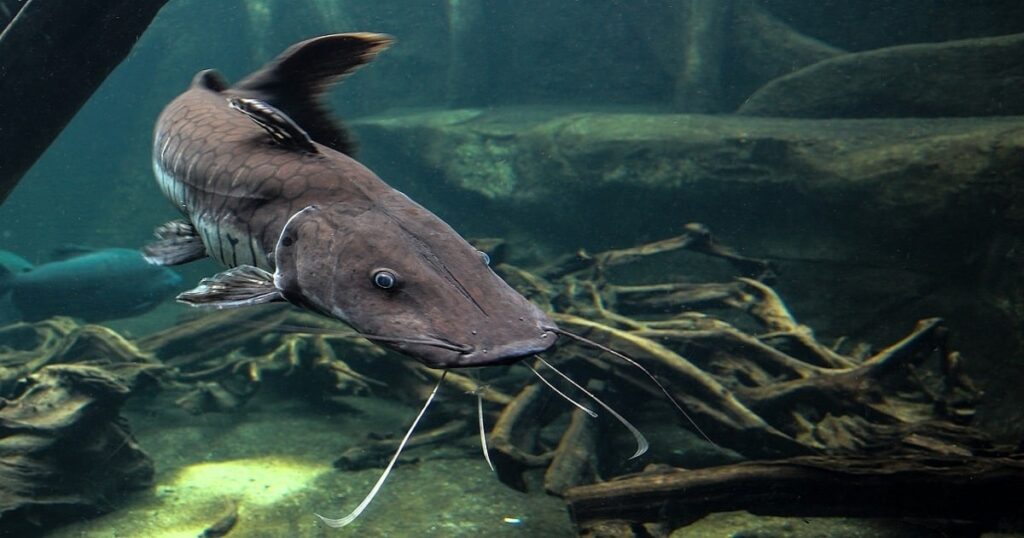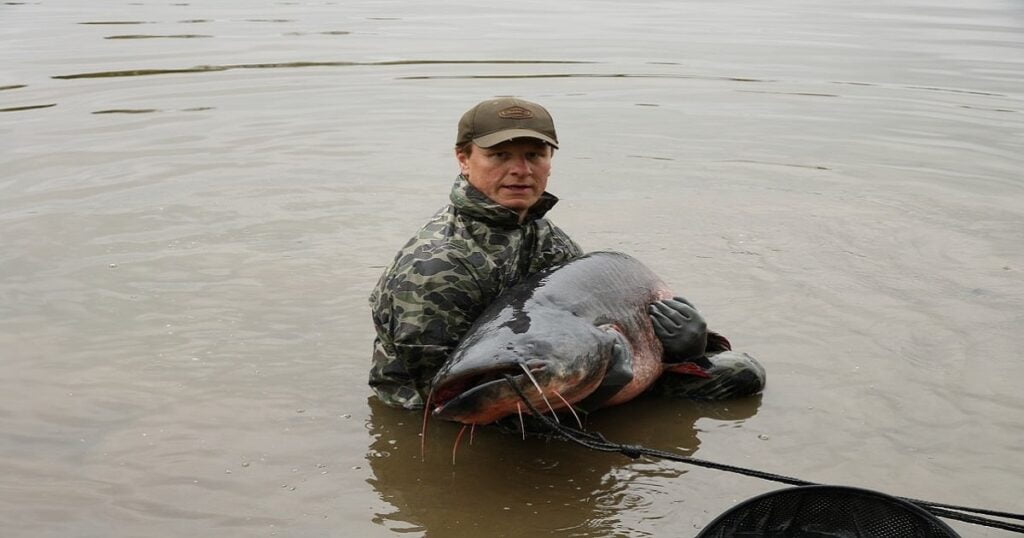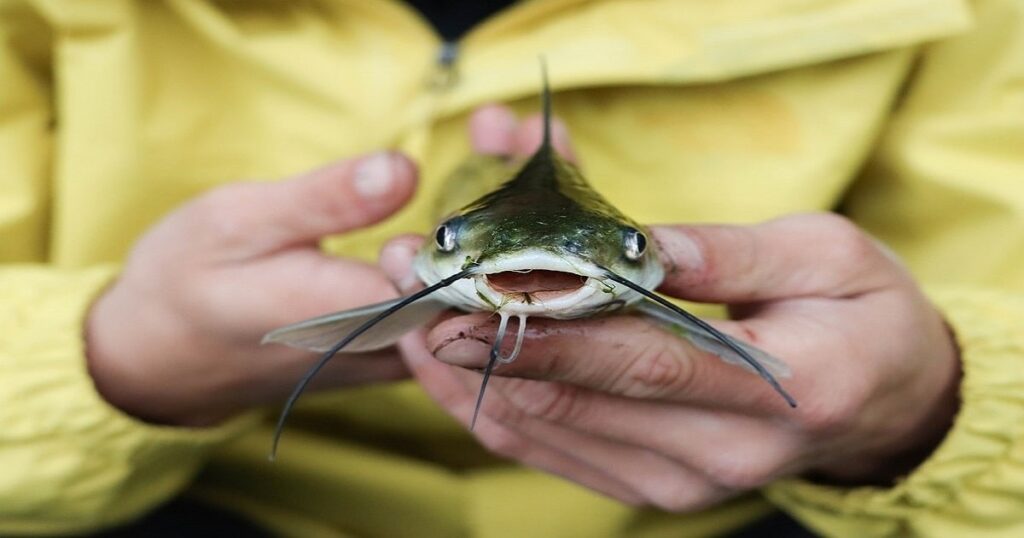Catfish, also known as Catfishes, are a diverse group of fish named after the presence of barbels around their mouth, which look like a cats whiskers. Most catfish have four barbels under their jaw and one on each tip of the upper jaw and this, combined with their long, cylindrical, scale-less body, makes them easily identifiable to anglers.
There are over 3,000 species of catfish found all over the world with around 40 species found in North America alone. The main types of catfish that anglers fish for are:
- Wels catfish – these are native to Europe and found in rivers and lakes all over the continent and can grow to 300lbs in weight.
- Channel catfish are the most common type of catfish in the United States. They are found in rivers, lakes, and ponds all over the country.
- Blue catfish are another large species of catfish in North America. They can grow to over 100 pounds, and they are usually found in large rivers and lakes.
- Flathead catfish can grow to over 100 pounds, and they are found in large rivers and lakes across North America.
- Mekong giant catfish are mainly found in South East Asia and can grow to be one of the largest freshwater fish in the world.
There is also a wide variety of smaller catfish that make their way into aquariums across the globe. Some of the more interesting variants are the Red-Tailed Catfish, which is usually found in the Amazon. The Upside-Down catfish, known for its fondness of swimming upside down, and the Bristlenose Pleco, an aquarium owners favourite as it feasts on algae growing in the tank and helps keep it clean.
Habitat
Catfish are a freshwater fish and can be found in plenty of rivers, streams, lakes and reservoirs all over the world. The larger specimens tend to be caught in deep, fast-flowing rivers so anglers looking to target bigger catfish should concentrate their efforts on those types of locations.
Catfish are bottom-dwellers, this means they usually swim and feed across the bottom of the lake or riverbed.
In lakes catfish can often be found lurking in the deepest sections and anywhere near structures that provide cover and shelter, assisting the catfish while it stalks its prey. They are also known to feed around the weed edges and lake margins, especially as day turns to night, so anglers should not forget those spots.
In rivers the most likely areas to locate catfish are in the deepest sections of the river. Anglers generally target deep holes and areas in and around drop-offs with great success and any bends in the river offer you a good starting point if nothing else to go on. As catfish are a predatorial fish keep an eye on any areas that may provide them with a source of cover as they will often be swimming close by.

Feeding Habits
Catfish are active during all times of the day but generally they have a nocturnal tendency so become especially active during the hours of darkness. As catfish have a heightened sense of smell and taste they use this, in combination with their barbels (cat whiskers), to navigate around their habitat and locate various food sources.
Catfish eat a mix of both plant and animal material so this makes it a great deal easier for the angler as a catfish can be caught on almost anything you can attach to a fishing hook!
Some of the best baits anglers use for catfish are:
- Live or dead baits – maggots, bunches of worms, minnows, shad and roach can all be used with great effect.
- Artificial baits – boilies, catfish pellets, spicy sausages, chicken livers or even catfood (yes, catfish like catfood very much!)
- Lures – Jigs, crankbaits and spinnerbaits are popular. As are the slip bobber and carolina fishing rigs.
One of the most popular ways to catch catfish is to use live bait. Worms, minnows, and insects are all good choices for live bait. When using live bait, it is important to keep it fresh. Catfish are attracted to fresh bait, and they will be more likely to bite if your bait is fresh.
Another popular way to catch catfish is to use artificial lures. There are many different types of artificial lures that can be used to catch catfish. Some popular catfish lures include jigs, crankbaits, and spinnerbaits. When using artificial lures, it is important to fish them slowly and steadily. Catfish are not usually aggressive fish, and they will usually take a long time to bite.
As with all fishing try to seek out some local knowledge on what the catfish have a preference for in your area, but don’t be worried about trying something new.
Catfish Size and Lifespan
There is a lot of variance in sizes and age across the catfish family. Some of the smaller members of the catfish family, those found mainly in home aquariums, live for between 5 and 8 years and will grow no more than 5 inches in length.
In contrast the majority of catfish anglers target will live for between 5 and 20+ years with the bigger ones able to achieve a length in excess of 4ft (1.2m) and a weight over 100lbs (45kg).
World Record Catfish – here are the best:
- Mekong giant catfish – Recorded as the largest freshwater fish ever caught this whopper weighed in at 646lbs (293Kg) and measured over 9ft (2.7m) in length. It was caught in Thailand, May 2005.
- Wels catfish – Caught from Italy’s largest river, the Po Delta, the weight of the record, set in 2019, varies between 280lbs and 317lbs depending on the source. Either way it’s a huge fish measuring in at over 9ft (2.7m) in length.
- Blue catfish – The world record blue catfish was caught from Kerr Lake in Virginia, USA back in 2011. At 143lbs and just under 5ft (1.5m) in length this record looks set to stand for many more years to come.
- Flathead catfish – The biggest Flathead catfish on record was expertly pulled from the Elk City Reservoir, Kansas, USA in 1998. The flathead measured in at 5ft (1.5m) and weighed 123lbs (56kg).
- Channel catfish – Standing since 1964, this ancient world record for a channel catfish was caught from Lake Moultrie in South Carolina. It weighed in at 58lbs (26kg) and measured 48inches (122cm) in length.

Catfish Tackle
You don’t need to spend much money to get started in catching catfish. For small to medium sized catfish most a basic 6ft+ fishing rod and either a fixed spool or baitcaster reel will suffice as long as they are equipped with a good quality fishing line (6lb+) and sharp hook.
When targeting the bigger specimens in large fast-flowing rivers or deep reservoirs heavier duty equipment is required. A high quality baitcasting or specimen fishing rod with a 4lb+ test curve is required. This, along with a heavy-action baitcasting reel or big-pit fixed spool reel with 25lb-80lb monofilament line should cope with some of the biggest fish. In situations where rivers or lakes are particularly rocky consider upping to braided lines. As for hooks this depends on your bait but choose a high quality brand in a 1/0 or 2/0 size, up to 6/0 when using larger live and dead baits.
Another aspect of catfishing tackle to consider is your night fishing equipment. If you choose to target bigger catfish then you will spend a lot more time under the stars in your pursuit. Consider investing in some warm clothes, a head torch, a comfy bedchair and a small tent or bivvy to make those nights fishing more enjoyable.
Top Tips for catfish fishing
Here are some top tips for catching a catfish:
- Study the water – catfish love deep muddy water and areas with some structure so look out for these spots. On rivers Catfish can also be found in deep holes, river bends and in and around weeds.
- Target the bottom – catfish are mainly bottom feeders so make sure to present your bait or catfish lure on or near the bottom of the lake/river for best results.
- Use a variety of baits – catfish eat pretty much anything but anglers tend to opt for high-attract baits that give off plenty of smell and oils. Go traditional with worms or experiment with catfish pellets and spicy sausage, the choice is yours!
- Ask for local knowledge – You might be wondering “is there any catfishing near me?” and the chances are most likely yes. Call, or even better visit, your local angling shop and ask around. Anglers love to help each other and offer advice to newcomers and will help you find catfishing spots near to you.
- Have fun – above all fishing should always be fun. Catching catfish can be a challenging but rewarding experience. With a little patience and skill, you can catch these beautiful fish.
